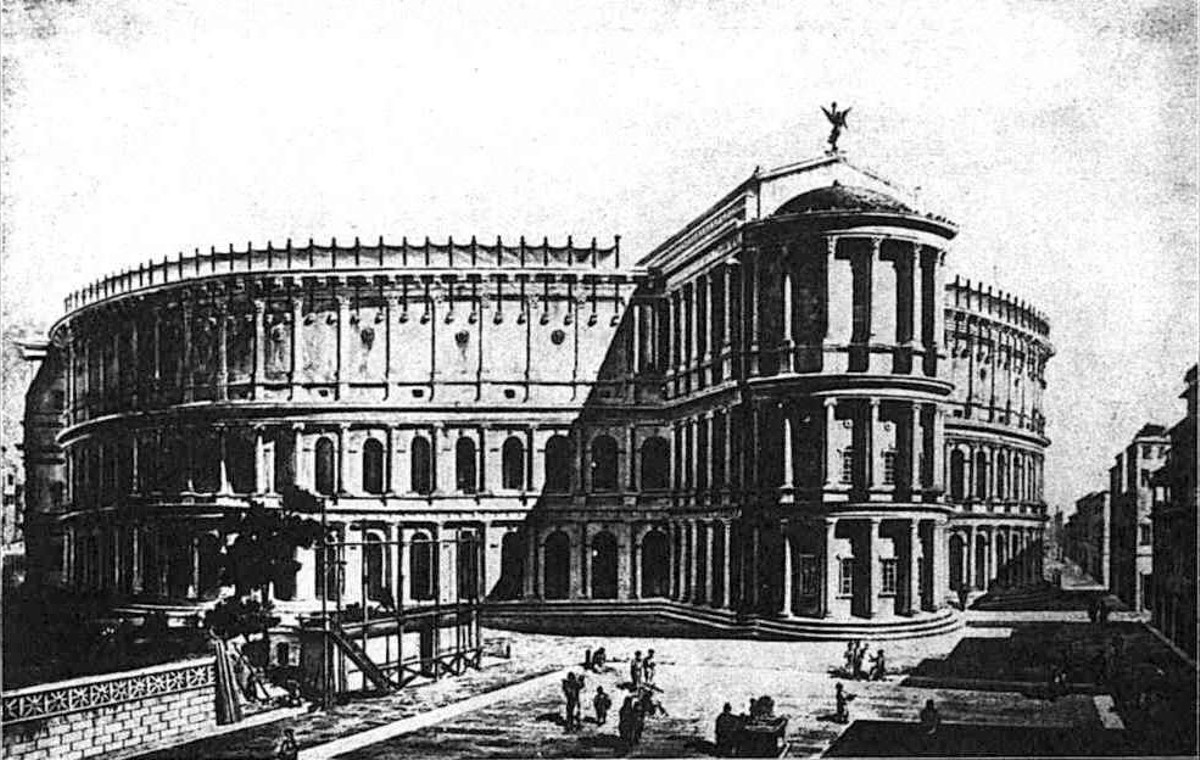Uncovering the Ancient Theater of Pompey: A Journey into Roman History

December 5, 2023
In the heart of Rome, hidden amidst the bustling streets of the Parione district, stands a peculiar six-story building with a unique shape. Little do passersby, whether locals or tourists, realize that underneath this structure lies the ancient theater of Pompey, one of the oldest theaters from the Republican era. Although there are few visible remnants today, such as columns and fragments of ancient walls within nearby shops, the history of this remarkable theater can be found online. However, locating its physical traces on-site proves to be a challenge.
The History of the Theater and Curia of Pompey
Constructed under the consulship of Pompey the Great between 61 and 55 BC, the theater had an impressive diameter of 150 meters and accommodated up to 17,500 spectators. Adjacent to the sacred area of Largo Argentina, the theater boasted a quadriportico adorned with columns that extended towards the Curia. It was within this Curia that the infamous assassination of Julius Caesar took place on the Ides of March in 44 BC. Following this event, Augustus prohibited access to the Curia, while the theater continued to function until the 5th century AD. However, during the Middle Ages, the theater became a quarry for building materials and the foundation for subsequent structures.
The Teatro Argentina, built in the 17th century, stands on the site of the porticoes adjacent to the ancient Theater of Pompey. According to the Capitolina Superintendence, the Theater of Pompey was “the first theater in masonry of the Republican period.” Unfortunately, there are no explanatory panels today to indicate the presence of this ancient and monumental structure. Many tourists visit Via di Grottapinta, expecting to find the remnants of the theater, possibly having seen online references to the site. Disappointed, they find neither the remains nor informative signs about its existence. In response to this issue, the local municipality has proposed collaborative efforts with other institutions to promote awareness of the ancient theater.
The Proposal by the Municipality
The upcoming Expo2030 presents a prime opportunity for rediscovering the ancient theater of Pompey. With millions of Italian and international visitors expected to flock to the city, especially in the UNESCO area, the municipality aims to take swift action. The municipal council, with a significant majority, has urged its government to initiate a “design and consultation table” involving the municipality itself, the Special Superintendence of Rome, and the Capitolina Superintendence.
The objective is to create a tourist route that explores the ancient theater, making the underground areas accessible wherever feasible and reconnecting the excavations of the Theater of Pompey with street-level access. Additionally, the installation of informative panels indicating the presence of the ancient structure is proposed. This initiative could be implemented promptly, regardless of Rome’s potential hosting of Expo2030.
Exploring the Underground Marvels of the Ancient Theater
One of the main goals of the proposed project is to allow visitors to explore the underground wonders of the ancient theater of Pompey. By creating access points and reconstructing the connections between the excavations and street level, a captivating journey through history can be crafted. Imagine descending into the subterranean depths, where the echoes of ancient performances still resonate. Walking through the passageways, visitors can marvel at the architectural ingenuity of the Romans and visualize the grandeur that once graced this remarkable theater. The proposed tourist route aims to create an immersive experience, transporting visitors back in time to the heyday of Roman entertainment.
Unveiling the Architectural Splendor
The ancient theater of Pompey was renowned for its architectural splendor, combining functionality with artistic grandeur. The massive structure, with its towering walls and intricate design elements, captivated the imaginations of those who experienced it. The theater’s exterior featured a grand colonnaded quadriportico, extending towards the sacred area of Largo Argentina. This stately portico not only enhanced the visual appeal of the theater but also provided a space for social gathering and leisurely walks. Inside, the auditorium boasted tiered seating, accommodating thousands of spectators who eagerly awaited theatrical performances, gladiatorial contests, and even political speeches.
Preserving History: Challenges and Solutions
Preserving the ancient theater of Pompey poses numerous challenges due to its long history of reuse and repurposing. Over the centuries, the theater became a quarry for construction materials, and subsequent buildings were erected upon its foundations. The layers of history and urban development have made it difficult to isolate and protect the archaeological remains. However, with the proposed initiative to open the underground areas to the public, efforts to preserve and safeguard the theater’s remnants will be heightened. Advanced conservation techniques, ongoing monitoring, and collaboration with archaeological experts will ensure the long-term preservation of this invaluable historical site.
Reviving the Spirit of the Ancient Theater
The revival of the ancient theater of Pompey goes beyond the physical preservation of its remains. It seeks to reignite the spirit of cultural and artistic expression that once graced its stage. By opening the underground areas to the public, visitors will have the opportunity to appreciate not only the architectural marvels but also the historical and cultural significance of this ancient site. Through the proposed tourist route, guided tours, and educational programs, the theater can become a vibrant hub for cultural events, performances, and exhibitions that celebrate Rome’s rich heritage and artistic legacy.



